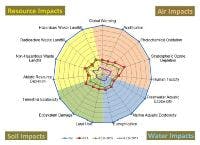The study aimed to understand the impacts of the manufacturing process for a white-light LED lamp. The lifecycle analysis (LSA) looked at the impacts associated with a representative LED lamp and compared that to a CFL and an incandes¬cent lamp. The comparison took into account the LED lamp as it is in 2012 and then projected forward what it might be in 2017, accounting for anticipated improvements in LED manufacturing, performance, and driver electronics. Part 2 confirmed that energy-in-use is the dominant environmental impact, with the 15W CFL and 12.5W LED lamp performing better than the 60W incandescent lamp, for instance.
The study considered 15 environment impact measures and the results have been plotted in a spider graph (shown). The relative impact of CFL, LED 2012 and LED 2017 are represented by the distance from the center point on the graph relative to the impact of the incandescent lamp, which has the most severe impact and makes up the perimeter. The low efficiency and high quantity of electricity required for incandescent lamps contribute to its poor lifecycle cost as well as the need to manufacture and replace the units many more times than is necessary with CFL and LED lamps. The incandescent lamp is the most environmentally harmful across all fifteen impact measures.
The CFL is slightly more harmful than the 2012 integrally ballasted LED lamp across all criteria except one—hazardous waste landfill, where manufactur¬ing the large aluminum heat sink used in the LED lamp causes the impacts to be slightly greater for the LED lamp than for the CFL. The best-performing light source is the projected LED lamp in 2017, which takes into account several prospective improvements.
The summary report states “The important finding from the LCA study is not minor relative differences between the LED lamp and the CFL, but the significant reduction in environmental impacts from replacing an incandescent lamp with a more efficient product.”






